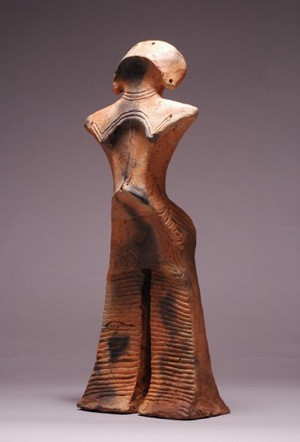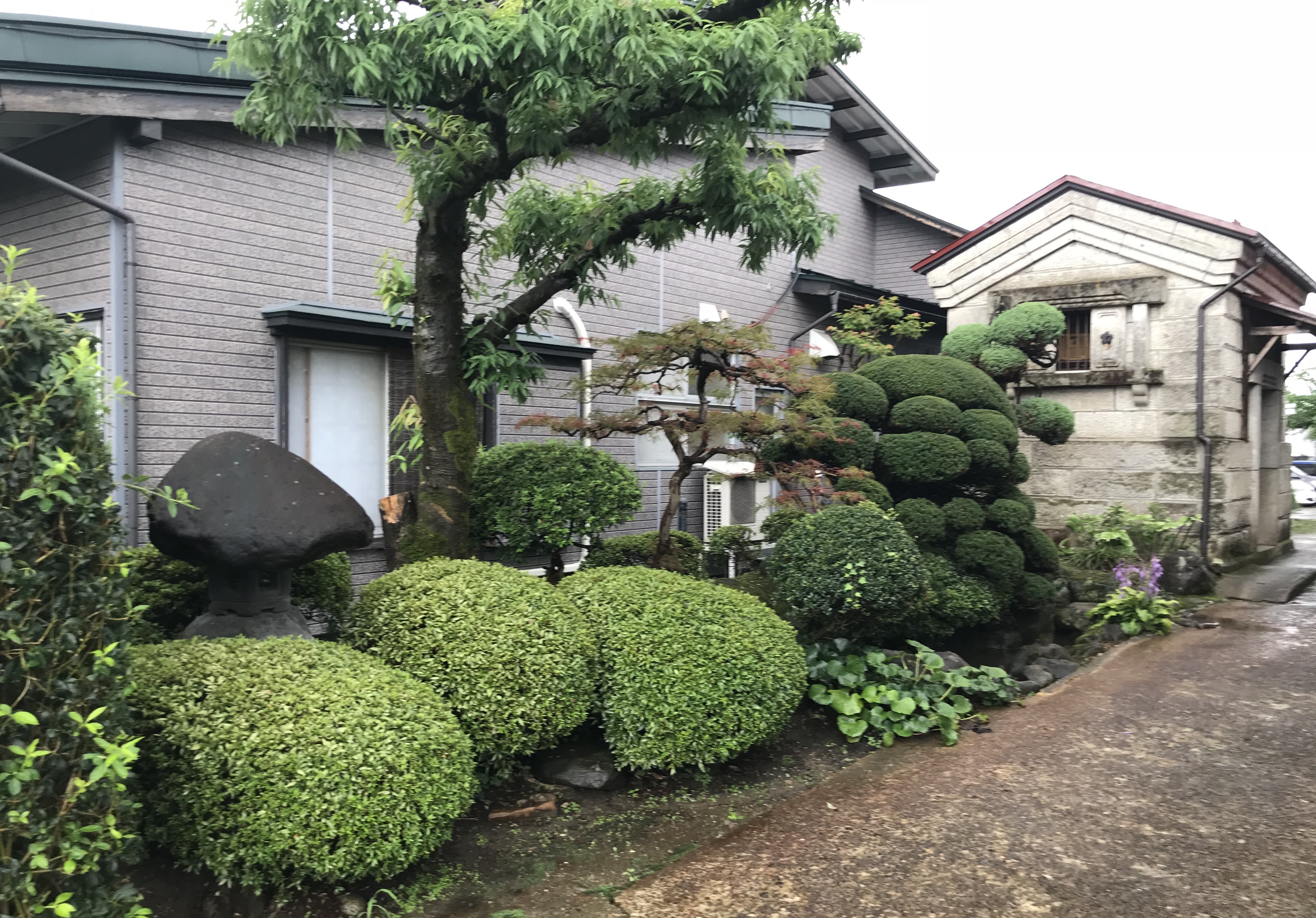When Japan’s most famous poet and travel writer Basho visited the remote mountain temple of Risshakuji in the summer of 1689, he wrote, in The Narrow Road to the Deep North (奥の細道):
The whole mountain was made up of massive rocks thrown together, and covered with age-old pines and oaks. The stony ground itself bore the colour of eternity, paved with velvety moss… As I moved on all fours from rock to rock, bowing reverently at each shrine, I felt the purifying power of this holy environment pervading my whole being.
He then composed the famous haiku:
閑さや岩にしみ入る蝉の声
In the utter silence
Of a temple,
A cicada’s voice alone
Penetrates the rocks.

Risshakuji from the village of Yamadera
Today, some 330 years later, in no small part thanks to Basho, the temple is a major tourist destination. The village of Yamadera, at the foot of the mountain, is easily accessible by road and rail, and its streets are lined with the same kind of cafes, restaurants, souvenir shops and car parks that populate every tourist town across Japan. This diminishes the sanctity of the place somewhat but once you climb the more than one thousand steps up to the shrines perching on the cliff-face you can still sense the power of the mountain and the overwhelming silence.
On the rainy afternoon that I visited Yamadera, the only other tourists were a group of young women from Tokyo more interested in souvenirs than spirituality and a middle-aged couple with expensive cameras. By mid-afternoon, most of the shop-keepers had given up on making more sales and were closing down for the day. A troupe of about a dozen Japanese macaques bounded down the hill and slid down the rain-soaked eaves in search of a snack.
As the rain relented, I began my ascent. I can’t really improve on Basho’s description but will just add that on this day, not even a cicada could be heard as the mountain was gently enveloped in mist. The only sound was my own breath as I slowly made my way up the steep steps. These days, you don’t have to scramble around on all fours as there are numerous concrete paths and staircases linking the shrines but it is still a precarious climb nonetheless, especially in the rain.
Yamadera is one of the few well-known tourist attractions in Yamagata, a mountainous prefecture about two and a half hours by Shinkansen north of Tokyo. The ski and hot spring resort of Mount Zao is just about the only other draw to the area. But with no snow and persistent rain during the summer, Mount Zao was not getting much traffic either.
For the most part, the people of Yamagata are left alone to live their lives peacefully and unhurriedly, in tune with the seasons, as they have for thousands of years.
 People first settled in the broad inland basin between the Dewa Hills and the Ou mountain range in northern Japan that is modern day Yamagata about 30,000 years ago. The rich biodiversity of the region allowed the human population to flourish, and during the Jomon period (14,000-1,000 BCE), the early residents of Yamagata produced some of Japan’s most outstanding pottery artefacts, including the extraordinary Jomon Venus (縄文の女神), (photo left), which is now on display in the Yamagata Prefectural Museum.
People first settled in the broad inland basin between the Dewa Hills and the Ou mountain range in northern Japan that is modern day Yamagata about 30,000 years ago. The rich biodiversity of the region allowed the human population to flourish, and during the Jomon period (14,000-1,000 BCE), the early residents of Yamagata produced some of Japan’s most outstanding pottery artefacts, including the extraordinary Jomon Venus (縄文の女神), (photo left), which is now on display in the Yamagata Prefectural Museum.
With the introduction of rice cultivation around 2,000 years ago, the population of the valley grew steadily and people eventually moved into more permanent settlements. Society became more structured and organized and the patterns of agricultural production, processing and trade that are still evident today were first established. Yamagata is still famed primarily for its rice, sake, fruit production, especially cherries, and its pork and beef. There is little large-scale manufacturing or heavy industry and although the prefectural capital of Yamagata city now has a population of around a quarter of million, it retains the feeling of a small market town.
There is nothing impressive or ostentatious about Yamagata city. There are no grandiose corporate buildings and none of the monuments to local heroes or historical figures that dominate many other prefectural cities in Japan. This might be because there are not many local heroes to celebrate. The only figure to get his own museum, a nondescript single storey concrete building adjacent to the castle ruins, is Mogami Yoshiaki, the local lord who guessed right and sided with the forces of the Tokugawa clan during the Battle of Sekigahara in 1600 and was rewarded by the new Shogun with the fifth largest fiefdom in the whole of Japan. His “achievements,” as recorded in the museum, include building the required castle and laying out a fairly standard castle town, dredging the Mogami River to make it more navigable and introducing some new crops. It was not much of a legacy and his clan’s influence gradually faded until the Tokugawa administration established direct control over the region. Life for everyone else carried on as normal; the rain fell, the river flowed, crops grew and were harvested, taken to market and processed for sale.
Today, Yamagata has a very egalitarian feel to it. Everyone appears to be comfortably and uniformly middle class. There are no obvious displays of wealth or poverty. Even in the smaller outlying towns of the Mogami River valley like Sagae, the low-rise houses are nearly all the same size and a regulation distance apart. Many have neatly tended gardens that reflect the residents’ pride in private property. I did see some larger houses in the old samurai district of Kaminoyama Onsen, 20 minutes south of Yamagata city, but again there was nothing overly flashy or ostentatious and there were no expensive cars parked in the garage. Compare that with upscale districts of Tokyo like Shinagawa, where you will see Ferraris, Bentleys and Porsches parked outside long lines of luxury condos.

Family home in Sagae, Yamagata.
Neither will you encounter anything like the crowds of commuters you find in Tokyo. Even during “rush hour,” Yamagata train station is calm and unhurried. No one is in much of a hurry to do anything in Yamagata. People go about their daily lives quietly, politely and in an orderly manner. The only “rowdy” element is the occasional group of uniformed high school kids hanging around the shopping centre. The downtown streets are largely deserted in the evening, even the bar area around the station which in most Japanese cities is the liveliest part of town, seemed quiet with just the muffled sound of drunken businessmen coming from inside a restaurant or hostess bar.
There was an attempt by the local merchants to liven things up and drum up some business on the Saturday evening I was in town by organizing an Awa Dance Festival on the main street. The Awa Dance Festival originated in Tokushima in the south but versions of it are now staged all over Japan. The Tokushima festival is akin to the Rio Carnival and attracts more than a million tourists each year. In Yamagata, there were a few-hundred people lining the streets to watch the dozen or so dance troupes pass by. It was a fun evening but at eight o’clock on the dot they pulled the plug. Everyone packed up and went home.

Awa Festival dancers in downtown Yamagata.
Some people might think Yamagata is deadly boring and perhaps it is but for me that is part of its attraction. It is a place where on the surface nothing much happens but what does happen is done well. Farmers take pride in producing the best cherries and peaches, and the sake brewers are so good at what they do that Yamagata is the only one of Japan’s 47 sake producing prefectures that has been awarded its own regional appellation, putting it on a par with Champagne and Bordeaux. Even something as simple as making a bowl of ramen or showing visitors around the Mogami Yoshiaki Museum is done with dedication and concern for customer satisfaction.
The prefecture has come up with an advertising slogan to promote its local brands and produce: 創造の山 理想の形, which is a play on the two characters in the name Yamagata (山形) and means something like “the mountains of creation produce the ideal form.” Of course, it is just an advertising slogan but it does seem to neatly sum up Yamagata’s artisanal heritage and creativity. Many other prefectures might make similar claims but in Yamagata, perhaps because it does not claim to be anything else or make any other ostentatious boasts, I am more tempted to believe it.
The translation of 奥の細道, quoted above, comes from the Penguin Classics, Matsuo Basho, The Narrow Road to the Deep North and Other Travel Sketches by Nobuyuki Yuasa.